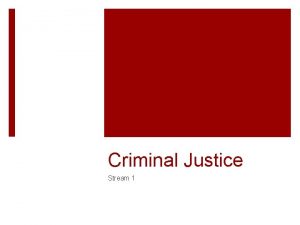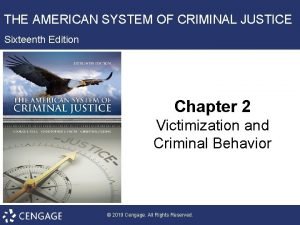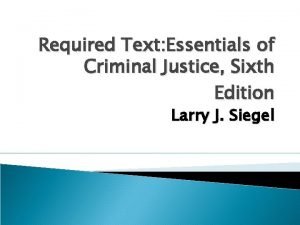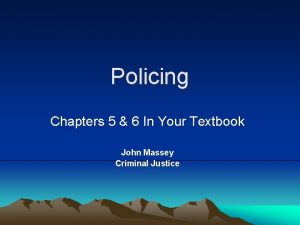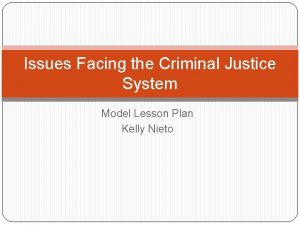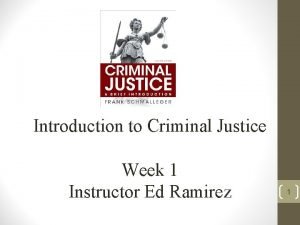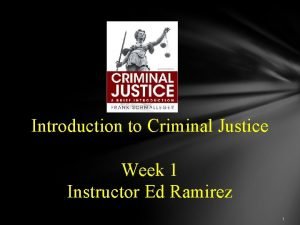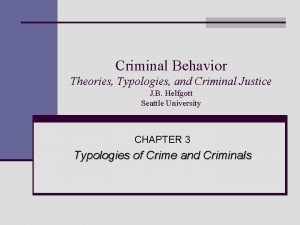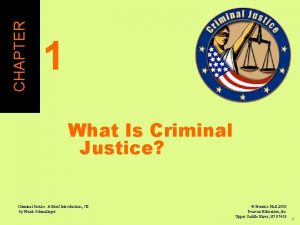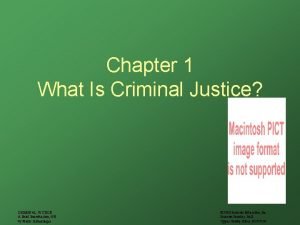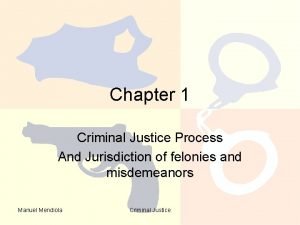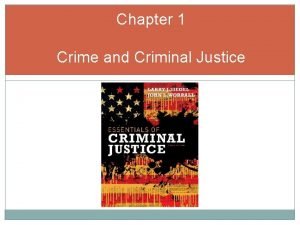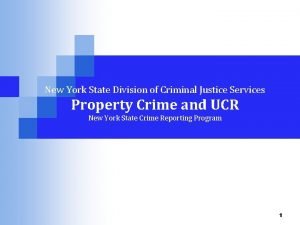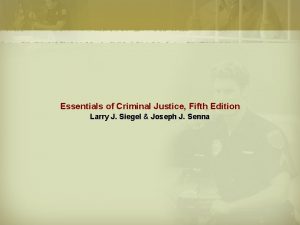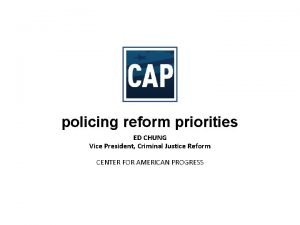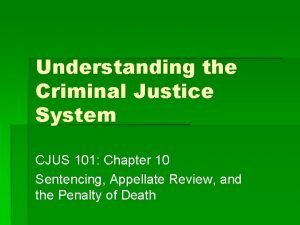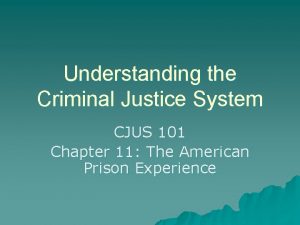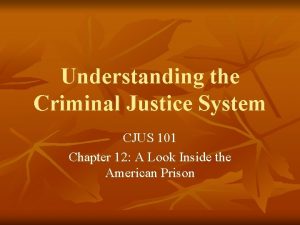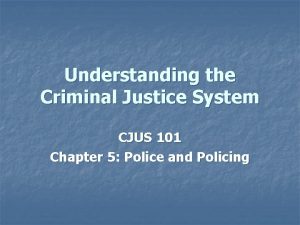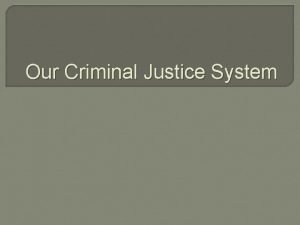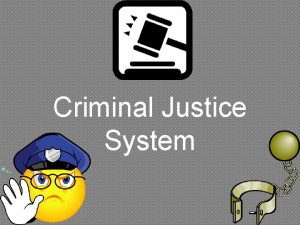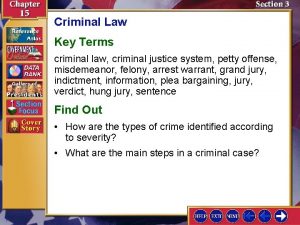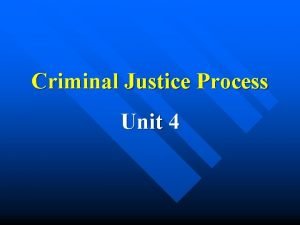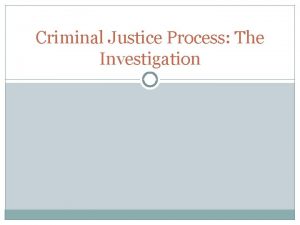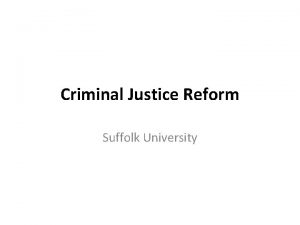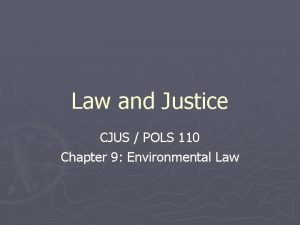Understanding the Criminal Justice System CJUS 101 Chapter



























- Slides: 27

Understanding the Criminal Justice System CJUS 101 Chapter 13: Inmate Rights

Rights 1. Prison conditions and inmate rights a. Civil death - considered “dead” civilly - if convicted of a felony (1) Lost all civil rights - recognized by courts until 1871 - Sec. 1983, Civil Rights Act of 1871 (2) Denied various rights

Rights - right to vote - hold public office - enter into public contracts - possess a firearm (2) Changed over past 50 years - have most constitutional rights - except voting / firearms (3) Until early 1960 s - courts would not hear lawsuits

Rights - no means of challenging conditions (a) Basic assumptions: - corrections not a judicial matter - convicted persons civilly dead (b) Prisoners relinquished constitutional right and privileges b. Prisoner rights movement - Civil Rights Act ended ‘hands-off’ doctrine

Rights (1) Inmates protected by Constitution - applied only to the federal system (2) States brought in at later time - no lawsuits until 1960 s (3) Filing lawsuits by inmates - 5 ways to make legal challenge (a) State Habeas Corpus challenge - bring the body forward

Rights - judge will hold hearing - unfairly incarcerated - rights violated (b) Federal Habeas Corpus challenge - filed directly into federal court (c) State Tort Suit - civil case filed - against officers / institution - change practice / no money

Rights (d) Federal Civil Rights Suit - 1983 lawsuit - monetary award / attorney fees (e) Class Action Suit - brought by federal government - all inmates receive consideration (4) Led to thousands of lawsuits - would sue for any reason - abuse / food / cell size / speech / etc.

Rights (a) Officials required to bring lawsuit before court (b) Produced few changes - considered nuisance suits (c) Some dramatic effects - food / religion / overcrowding / punishment / dress (d) Suits flooded court system

Rights 2. Changes made a. Profile of ‘typical inmate’ (1) 95. 6% male (2) 49. 7% Caucasian (3) 72. 4% under age 34 (4) 53. 7% single

Rights (5) 61. 6% less than 12 years education (6) 54. 6% convicted of violent crimes b. Basic rights (1 st / 4 th / 5 th / 6 th / 8 th / 14 th) (1) Freedom of speech - historically, denied use of mail/phone - incoming / outgoing mail censored - calls monitored - denied access to media

Rights (a) Supreme court struck down - posed a threat to security (b) Mail - personal / legal / religious - right to receive publications - can be limited (2) Freedom of religion -historically, a feature of prison life - inmates had to attend services

Rights (a) Restrictions - security / economic reasons / belief of the warden - aimed at religious rituals (b) Lawsuits by ACLU - Black Muslims - prohibited from banning - restrict those who abuse - no special diet - American Indian religion

Rights (c) Grooming / clothing - left up to states - haircuts / beards also (3) Right to privacy (4 th Amendment) - addresses people in a free society (a) No reasonable expectation (b) Provide custody / care / control - surveillance / inspection / search

Rights - even employees lose some expectation to privacy (4) Due process (a) Court ruled on “good time” - advance notice - hold hearing - obtain assistance (no attorney) - call witnesses (b) No right in prisoner transfer

Rights (5) Cruel / unusual punishment - 8 th Amendment (a) Court ruled on: - prison brutality / medical service - overcrowding / exercise options - food / clothing / others (b) Allowed double bunking - not lead to filth / disease - does not have to be kept clean

Rights (c) No limit on participation in programs (d) Did restrict solitary confinement - requires outside lighting (e) Prohibited corporal punishment (6) Rehabilitation - no constitutional right - to treatment / rehabilitation - state courts can impose

Rights (7) Medical services - provide adequate services - not cure all ills (8) Labor unions - no right to form or to join 3. Correctional officer rights - right to safety and protection a. Situations requiring several staff members

Rights - provided safety equipment - vests / helmets / shields / baton (1) Steps to insure safety (2) Right to use force - reasonable / necessary (3) Right to work - both male / female officers - right to compete for positions

Rights (4) Right to negotiate - work agreements / contracts 4. Prisoners: A profile - inmate characteristics - selection: social / economical a. Economical - people at lower end of economic scale - sent to prison more often - limited work opportunities / work skills

Rights - crime becomes legitimate endeavor b. Social - biased CJ system - discrimination found at all levels (1) Largest number of offenders - young / black (2) California: 847 Blacks per 100, 000 - 297 Hispanic / 95 White

Rights 5. Recidivism and crime - most discouraging aspect a. Tendency - continue in life of crime - after arrest / conviction / sentencing for earlier crimes b. Revolving door - each year: 260, 000 felons to probation - do little or no time

Rights (1) 4 out of 5: have prior convictions - half have 3 prior convictions - 1/5 th have at least 6 prior convictions (2) Washington state - 75% recidivist rate - 60% second incarceration c. Death row inmates - over 3, 000 on death row - 2/3 s convicted of prior felony

Rights - 1 in 11 were repeat offenders - 1/3 rd on probation / parole at time 6. Reduction of crime - incapacitation a. Reduce crime by locking up - complete sentence reduces crime by 25% b. Serve average of 35% maximum sentence - 15 years: 5 to 6 / 10 years: 3½

Rights c. Median time served - murder: 5 years / 10 months - rape: 3 years / 11 months - robbery: 2 years / 3 months - assault: 1 year / 4 months 7. Prison violence - first American prison riot was 1774 a. Fear of recurring violence plagues country - represent worse form of violence

Rights (1) Riots - prison violence - think of riots - relatively rare events (2) Most common prison violence? - day to day confrontations - among inmates - between inmate / correctional officer b. Historically

Rights - 300 riots since 1900 (1) Definition of riot - participation of 15 or more - resulting in property damage / injury (2) Majority - violence between / among inmates - fights / stabbings / beatings (3) Two types of violence

Rights (a) Instrumental - provides aggressor with power and status - improves self-image - sense of dominance over victim - most prevalent (b) Expressive - response to tension produced in prison environment - riots are usually expressive
 4 pillars of criminal justice system
4 pillars of criminal justice system Arizona criminal justice information system
Arizona criminal justice information system Responsibilities of saps in the criminal justice system
Responsibilities of saps in the criminal justice system Criminal justice in america 8th edition
Criminal justice in america 8th edition The american system of criminal justice 16th edition
The american system of criminal justice 16th edition Mexico criminal justice system
Mexico criminal justice system Guelph university criminology
Guelph university criminology Connecticut division of criminal justice
Connecticut division of criminal justice What is the criminal justice funnel
What is the criminal justice funnel What is a grass eater in criminal justice
What is a grass eater in criminal justice Criminal justice lesson
Criminal justice lesson Consensus model criminal justice
Consensus model criminal justice Consensus model criminal justice
Consensus model criminal justice Criminal justice corrections
Criminal justice corrections Consensus model criminal justice
Consensus model criminal justice Criminal typology
Criminal typology Consensus model criminal justice
Consensus model criminal justice Consensus model criminal justice
Consensus model criminal justice Consensus model criminal justice
Consensus model criminal justice Nonintervention perspective of criminal justice
Nonintervention perspective of criminal justice Criminal law and juvenile justice unit 2
Criminal law and juvenile justice unit 2 Criminal justice wedding cake layers
Criminal justice wedding cake layers Department of criminal justice services ny
Department of criminal justice services ny National archive of criminal justice data
National archive of criminal justice data Criminal justice wedding cake diagram
Criminal justice wedding cake diagram Criminal justice
Criminal justice Types of intermediate sanctions
Types of intermediate sanctions Conflict theory criminal justice
Conflict theory criminal justice
